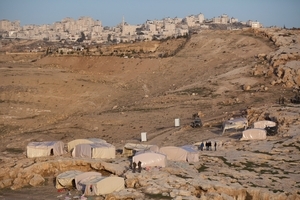By Amnesty International Campaigner Saleh Hijazi

Israeli border policemen guard the Bab al-Shams (Gate of the Sun) ‘outpost’ after evicting Palestinian protesters from the site on January 13, 2013 © Uriel Sinai/Getty Images
In the small hours of Sunday, more than 500 Israeli police surrounded around 130 Palestinian activists at a protest camp on the hills opposite the illegal Israeli settlement of Ma’ale Adumim, east of Jerusalem in the occupied West Bank.
The camp, which the activists called the village of Bab al-Shams (Gate of the Sun), was set up on privately-owned Palestinian land two days before to protest against the Israeli occupation and continued expansion of illegal settlements, which goes hand in hand with forced evictions in the West Bank.
Heavily armed police moved into the village to remove the peaceful activists on orders from the Israeli government, despite a High Court ruling on Friday not to remove the camp.
Eventually the video stream I was watching was cut off, but it was still possible to follow Twitter, where activists reported on the arrests and eviction moment by moment.
When I woke up in the morning, I began making phone calls to check on the activists.
I reached Zaid, an activist I met last year when he was beaten up by Palestinian Authority police forces for peacefully protesting in Ramallah.
He asked me to call later as he was in the hospital with his brother who was suffering internal bleeding near his eye because of police violence during the eviction; so much for the media reports and Israeli claims that the eviction had been carried out “peacefully”.
I tried others and eventually talked to Sameer via a video link. It was about 6 pm Jerusalem time and he had just woken up.
“I feel my body is one large bruise,” he said. “They beat me hard and the cold only made it worse.” He groaned with pain as he reached to grab a cigarette before describing what happened. He blew smoke and said:
“It was completely dark and extremely cold. There were hundreds of small lights – flashlights the riot police were carrying, coming from all directions. It was surreal, as if we were in a sci-fi film.
“At about 2 am they began to remove us. There were hundreds of riot police. With their equipment and body armour they looked like super cops, and there were only 130 of us huddled in the middle of the village.
“We did not resist the eviction, but we did not cooperate either. The soldiers began to remove us one by one, they kicked to separate us and then four to six soldiers would carry each of us away.
“I was repeatedly kicked so hard on my left leg that I felt it had broken. Three soldiers dragged me away, and when I was out of the journalists’ sight they started beating me with their elbows and kicking me on the back and then threw me on some rocks. Two of the soldiers kicked me while I was on the ground. I was hit on the neck and on my left leg again, and on my back.
“I was then put in a police bus with around 40 others activists, we were all on top of each other and some of us needed urgent medical attention. I could see the ambulances next to the detention bus, but they refused to treat anyone despite our repeated calls.”
Sameer lit another cigarette and continued:
“I need to go for a meeting now to discuss our next steps, but let me tell you: we will return to Bab al-Shams. Just like all Palestinian refugees since 1948 should return to their homes. This is only the beginning,” he said.
“The village represents non-violent and meaningful resistance – a practical challenge to Israeli oppression and injustice. It was created by young Palestinians without affiliation to any group or party. It is only natural that Israel wants to stop us. We expected the eviction, but this will never stop us from defending our human rights.”
The action was indeed inspiring. It presented a new and creative example of how Palestinians are peacefully defending their human rights. But the story of Bab al-Shams also reflects the wider experiences of many other Palestinians.
Near Bab al-Shams, in scattered communities in and around the area known as E1, live around 2,300 Palestinian refugees from the Jahalin Bedouin tribe. They have been there since they were forcibly displaced by Israel from their original homes in the Negev desert in the early 1950s. Some of them were also forcibly evicted again in the late 1990s to make way for the expansion of illegal Israeli settlements.
Today, the Jahalin live in the fear of forced eviction yet again as Israel announced in 2011 a plan to transfer them from the area to make way for new settlements. The majority of their houses, their schools, and other infrastructure have demolition orders which can be executed at any time.
The eviction of Bab al-Shams reflects the fate that the Jahalin tribes may face very soon if Israel goes ahead with its plans, confirmed last November and again on Sunday morning, to build more settlements in the E1 area.
The eviction of Bab al-Shams is a stark reminder that although Palestinians, and not Israeli settlers, have the right under international law to build and plan villages in the Occupied Palestinian Territories, every day the Israeli government continues to deny them those rights.
The international community should take this as a warning that if action against the expansion of illegal Israel settlements – especially the E1 plan – is not taken immediately, whole Palestinian communities will be forcibly evicted from their homes. Amnesty International will continue supporting these communities, and Palestinians’ right to peaceful protest.
Nice
What is with West Bank, For indian bank related queries check out website to know more information on
Bank IFSC Code